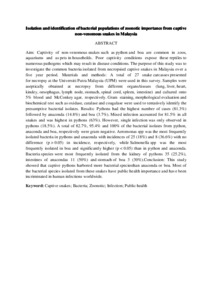Citation
Abba, Yusuf and Ilyasu, Yusuf Maina and Mohamed Noordin, Mustapha
(2017)
Isolation and identification of bacterial populations of zoonotic importance from captive non-venomous snakes in Malaysia.
Microbial Pathogenesis, 108.
49 - 54.
ISSN 0882-4010; ESSN: 1096-1208
Abstract
Aim: Captivity of non-venomous snakes such as python and boa are common in zoos, aquariums and as pets in households. Poor captivity conditions expose these reptiles to numerous pathogens which may result in disease conditions. The purpose of this study was to investigate the common bacteria isolated from necropsied captive snakes in Malaysia over a five year period. Materials and methods: A total of 27 snake carcasses presented for necropsy at the Universiti Putra Malaysia (UPM) were used in this survey. Samples were aseptically obtained at necropsy from different organs/tissues (lung, liver, heart, kindey, oesophagus, lymph node, stomach, spinal cord, spleen, intestine) and cultured onto 5% blood and McConkey agar, respectively. Gram staining, morphological evaluation and biochemical test such as oxidase, catalase and coagulase were used to tentatively identify the presumptive bacterial isolates. Results: Pythons had the highest number of cases (81.3%) followed by anaconda (14.8%) and boa (3.7%). Mixed infection accounted for 81.5% in all snakes and was highest in pythons (63%). However, single infection was only observed in pythons (18.5%). A total of 82.7%, 95.4% and 100% of the bacterial isolates from python, anaconda and boa, respectively were gram negative. Aeromonas spp was the most frequently isolated bacteria in pythons and anaconda with incidences of 25 (18%) and 8 (36.6%) with no difference (p > 0.05) in incidence, respectively, while Salmonella spp was the most frequently isolated in boa and significantly higher (p < 0.05) than in python and anaconda. Bacteria species were most frequently isolated from the kidney of pythons 35 (25.2%), intestines of anacondas 11 (50%) and stomach of boa 3 (30%).Conclusion: This study showed that captive pythons harbored more bacterial speciesthan anaconda or boa. Most of the bacterial species isolated from these snakes have public health importance and have been incriminated in human infections worldwide.
Download File
![[img]](http://psasir.upm.edu.my/62235/1.hassmallThumbnailVersion/Isolation%20and%20identification%20of%20bacterial%20populations%20of%20zoonotic%20importance%20from%20captive%20non-venomous%20snakes%20in%20Malaysia.pdf)  Preview |
|
Text
Isolation and identification of bacterial populations of zoonotic importance from captive non-venomous snakes in Malaysia.pdf
Download (97kB)
| Preview
|
|
Additional Metadata
Actions (login required)
 |
View Item |

